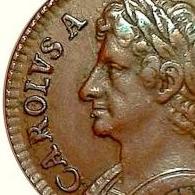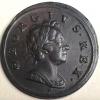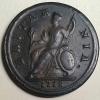-
Posts
1,509 -
Joined
-
Last visited
-
Days Won
51
Content Type
Profiles
Forums
Events
Downloads
Store
Gallery
Articles
Everything posted by Michael-Roo
-

1700 1/2d T over A in Britannia
Michael-Roo replied to Michael-Roo's topic in Confirmed unlisted Varieties.
'Tumbled T'. Wasn't he one of the Whitechapel Murders suspects? I agree. The oblique leg on the right should be thicker if it were an A. It does remain though, there is a corresponding left oblique leg too. Its foot gives the effect of an elongated foot to the foot of the overlying T. Could the underlying letter be an inverted or mirrored V? -

1717 Halfpenny…..
Michael-Roo replied to Michael-Roo's topic in British Coin Related Discussions & Enquiries
Who knows? I suppose, most likely the price of a currency piece in the same grade plus a bit of a premium. William & Mary proof halfpennies and farthings turn up in everything from FDC down to VG, and they all seem to sell ok. It was sold to me simply as a 1717 halfpenny. It was me who noticed it could be a proof specimen. I've no intention of selling anyway. It was just something I thought fellow Forum members might like to see -

1700 1/2d T over A in Britannia
Michael-Roo replied to Michael-Roo's topic in Confirmed unlisted Varieties.
Good point P. Worth mentioning though that the appalling quality of original strike has to be considered when looking at this series. I have some examples which would grade as VF or better yet some areas have been so weakly struck as to leave those parts of the design less visible (rather than as a result of wear). Did you notice my coin and the Nicholson good fine/fine example both have the exact same little bit of extra metal/die clutter near Brit's arm in the reverse field? Not important, just interesting. They must have been struck quite closely to each other. Any thoughts regarding the underlying oblique bar and extension to the foot of the T on the lefthand side? -

1700 1/2d T over A in Britannia
Michael-Roo replied to Michael-Roo's topic in Confirmed unlisted Varieties.
I'm happy to go with that. As mentioned, even though I estimated as fine/near fine, the condition is comparable to the Nicholson good fine/fine, and I've been trusting to the photos in that collection when estimating the grades of my William III 1/2ds. I guess some of Nicholson's must be over graded then. As for the likelihood of the underlying letter being something other than an A I'm happy to consider that too (again, I was going with the description in Nicholson collection for this). I would point out though there is a corresponding oblique bar to the left of the T too, which isn't as obvious in the photo as I'd hoped it would be. However, something which is obvious is that the foot of that oblique gives an elongated appearance to the foot of the T on the left side. It would be nice to nail the overstrike with some certainty. Hopefully someone, somewhere, has a higher grade example for our consideration. Fascinating stuff either way….. -
An unlisted variety for 1700. I have only been able to find three examples of this one. Two are in the Dr.Nicholson collection: The first graded Good Fine/Fine. The second, Fair. Dr.Nicholson rates the variety as 'extremely rare'. The third coin is my own (pictured). Although I would rate it as Fine/Near Fine it is comparable with the Good Fine/Fine Nicholson example. The overstrike is clear and unmistakeable.
-
May as well stick this one in here too as that's what this section is intended for... An unlisted variety but three examples are known. DNW auction, June 2006 (Fine). The Dr.Nicholson collection (Good Fine). My coin (pictured) (Very Fine). The overstrike is clear and unmistakeable.
-

1717 Halfpenny…..
Michael-Roo replied to Michael-Roo's topic in British Coin Related Discussions & Enquiries
Thanks Cop. The legend letters are larger and better executed than the currency too, aren't they. Did you take a look at my 1718 N over A in Britannia 1/2d? Apart from the DNW auction and Nicholson collection I've still not been able to find any reference to this variety. Asda graded it a VF. After another look I think I'd go with that too. Still much better than the two I was able find mention of (Fine, and good fine). -
I've had this for a few years. Although it displays some wear I've always believed it to be a proof. Its a bit thicker than the currency examples I have. The design is in higher relief, and the toothed border much more sharply defined. Also; the colour is a milk chocolate shade, lighter than would usually be expected for one of these. What do you think? As usual: apologies for the less than stupendous photography. I really must get a better phone….
-

1718 1/2d unrecorded overstrike.
Michael-Roo replied to Michael-Roo's topic in British Coin Related Discussions & Enquiries
My attempts at re-photographing were rather poor. Way too dark. So, I've adjusted the original photos. A slight improvement, but still not showing as much detail as I'd hoped. The coin is much better than this (sharp hair curls, armour, Brit's face etc)…. -

1718 1/2d unrecorded overstrike.
Michael-Roo replied to Michael-Roo's topic in British Coin Related Discussions & Enquiries
Hi A. The coin is much sharper than these photos would suggest. I'll try to get better ones later today. Its certainly better than other 1717/1718 halfpennies I have which I would consider VF. The Nicholson example didn't sell, but I've found record of a DNW auction in June 2006 where one in Fine condition sold for £100. This, and the Nicholson collection listing are the only references I can find. http://www.dnw.co.uk/auction-archive/prices-realised/results.php?auction_id=81&layout=detailed&offset=400&limit=80 -
Here's a 1718 dump halfpenny GVF with the first N of Britannia struck over an A. An unrecorded variety, but I see there is a less well preserved example (GF) which appears in the Dr. Basil Nicholson collection where it is described as 'extremely rare'. Would anyone care to suggest a value for my coin? Thanks all.
-
Actually, when I said 'NVF' I was being optimistic. Its very nice but, I think P is more accurate. I'd probably be happier with 'bold' good fine (now there's a contentious grading, if ever there was one!)….. I have a 1673 no obverse stops farthing. Colin Cooke's notes say he knew of only four examples. None better than good fine. Indeed, the one in his collection is only near fine (IMHO), although he listed it as fine. I have two. One near fine (similar in grade to his). The other what I would describe as (here we go again) bold good fine. Who knows. Maybe one of the best examples surviving? Should I upload images?
-
Thank you Chris. I just happened to be going through my tray of C18th tokens and noticed this overdate. I've had most of these for 20+ years, so its odd I'd not noticed before. This afternoon I've been consulting the D&H book online and it seems to be No.89, which they list as RRR. Nice to know but of no importance. I'm not looking to sell it.
-

1870 Penny.
Michael-Roo replied to Michael-Roo's topic in British Coin Related Discussions & Enquiries
Sorry. Just seen your mention of a missing Rev.D being a possible 12 1/2 date width. Still makes the A/B/C/D/E thing a bit confusing for me (laughs). 13 deffo the wide date then. Just wondering how rare it might be. -

1870 Penny.
Michael-Roo replied to Michael-Roo's topic in British Coin Related Discussions & Enquiries
Thank you J. Mine is 13 teeth, as can be clearly seen from the photo I attached. I"m now a little confused. The only web info I could find for him stated there are three reverses, 13 teeth being Rev.C (A being 11 teeth. B being 12 teeth) What is Rev.e E? And, indeed, in that case, what is Rev. D? Either way, at 13 teeth being an example he'd only ever seen one example of, it looks like mine is the rarest variety after all? -
You can see can't you, how someone like me who is out of his comfort zone when attempting to I.D tiny hammered coins like these, can get it wrong. I was convinced the first coin was showing annulets, as per 1912A or, as Geordie suggested: 1852.
-

1870 Penny.
Michael-Roo replied to Michael-Roo's topic in British Coin Related Discussions & Enquiries
Thanks V. -
Thank you again. I bought the coin with which I began this thread as an 'unresearched hammered farthing' around two or three years ago. The one I've since added to the photo was bought as 'hammered halfpenny, possibly ED I-ED III' around the same time. Nothing groundbreaking but, as the total cost for the two came in at about £12, definitely worth having! :-)
-

1870 Penny.
Michael-Roo replied to Michael-Roo's topic in British Coin Related Discussions & Enquiries
Thanks both. I don't have the books. Hopefully someone reading the thread topic, who does, will be kind enough to look it up for me. I can't find anything on the interweb (apart from M Gouby's date width varieties). I can't find any info for him having had a reverse C (13 teeth) for sale, which led me to believe it might be the rare one. Any thoughts regarding the absence of die flaw on the colon after D on the obverse? Peck. I'd rated as near EF too. Ta! -
Here it is next to a coin I did buy as a hammered halfpenny. You're right, I think. Even though the other coin is a little larger the inner circles are the same size on both. Can you identify this second coin?
-
They do look similar, don't they. One thing I notice though: mine has a bust which looks smaller within the inner circle than yours does. You're probably right about the annulets, though they do seem more pronounced in the first photo I took, even though its not as sharp as the second.
-
The distinctive sloping shoulders may help identify it? Annulets too.


















